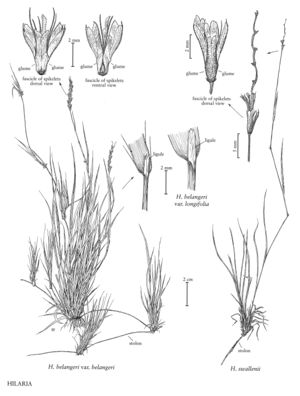Difference between revisions of "Hilaria swallenii"
FNA>Volume Importer |
FNA>Volume Importer |
||
| Line 38: | Line 38: | ||
|publication year= | |publication year= | ||
|special status= | |special status= | ||
| − | |source xml=https://jpend@bitbucket.org/aafc-mbb/fna-data-curation.git/src/ | + | |source xml=https://jpend@bitbucket.org/aafc-mbb/fna-data-curation.git/src/f6b125a955440c0872999024f038d74684f65921/coarse_grained_fna_xml/V25/V25_921.xml |
|subfamily=Poaceae subfam. Chloridoideae | |subfamily=Poaceae subfam. Chloridoideae | ||
|tribe=Poaceae tribe Cynodonteae | |tribe=Poaceae tribe Cynodonteae | ||
Revision as of 20:25, 24 September 2019
Plants perennial; stoloniferous. Culms 10-35 cm, erect; nodes villous. Sheaths slightly scabrous; ligules 2-2.2 mm; blades to 8 cm long, 1-2 mm wide, mostly basal, both surfaces scabrous, sometimes also sparsely pilose. Panicles 1-4 cm, with 2-8 fascicles; fascicles 6.5-8 mm. Lateral spikelets with 2 florets, lowest florets usually sterile, distal florets staminate; glumes unequal, thick, indurate, and conspicuously fused basally, mostly gray to dark brown, evenly and sparsely to densely spotted with dark glands, awned from above midlength, margins hyaline; anthers 3, 3-3.5 mm. Central spikelets with 1 pistillate floret; lemmas elliptic basally, narrower and parallel-sided distally. 2n = 54, 72.
Discussion
Hilaria swallenii grows on dry plains and rocky mesas in New Mexico, Texas, and northern Mexico. It is considered better forage than H. belangeri, but it is less important because it is less common.
Selected References
None.
